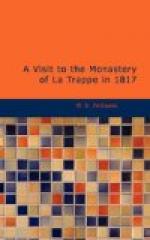Its ancient cathedral is in good preservation, notwithstanding it became a prey to the licentious fanaticism of the republicans.
The hotel Saint Julien, where I resided during my stay, stands upon the cloisters of an ancient abbey; and the church, with its fine Gothic pillars, and chapels, remains a monument of those destructive and desolating times! The side aisles are stalls for horses and cattle, and the centre is a remise for carriages and the public diligences which run to this inn! The best hotel is the hotel du Faisan. The vast number of English who keep pouring into all the western provinces of this country, by degrees has affected the markets, and will continue to do so, as long as the rage for emigration lasts. At Tours, every article is one third dearer than at Nantes, and in proportion as the capital is approached every thing becomes more expensive; yet notwithstanding this, living is, and must ever be, infinitely cheaper than in England.
It certainly is no exaggeration to say, that France is richer in the production of fruits and vegetables than any country in Europe, for in no other can be found so many productions of the same climates of the earth, or a soil more naturally abundant. With the exception of some of the northern provinces, every part of France has wine, and the culture of that delicious fruit which produces it is mentioned in its earliest records. By a happy distribution, those provinces which do not bear the vine, are abundantly supplied with other productions. Normandy and Bretagne abound in the finest fruits; Picardy, and the adjoining provinces, in corn. The riches of Lorraine are in its woods; Touraine has ever been famous for its plums and its pears. The banks of the Loire, and the valleys of Dauphine, are celebrated for the richness of their verdure and vegetation; and the more southern provinces of Languedoc and Provence, partake of the climate and productions of Italy and Spain.
Between Tours and Amboise, I passed the once celebrated Chateau of Chanteloup, formerly the property of the Duc de Choiseuil, now the residence of the Comte de Chaptal, who became the purchaser when it was sold as national property.
At the distance of six miles from Blois, the road leads near enough to Valencay to have a good view of its magnificent palace and grounds; this place, now belonging to M. de Talleyrand, Prince et Duc de Benevento, (one of the most extraordinary characters who have figured so conspicuously during the present age,) is the more interesting, from having been so long the place of confinement of Ferdinand the present King of Spain; and from whence our government tried to extricate him through the agency of Baron de Kolly, who lost his life in the attempt. This singular transaction has appeared in all the public papers, but having had an opportunity of collecting the particulars through a channel of undoubted authority, I consider it an anecdote of too interesting a nature, as connected with the subject before me, not to insert it here.




